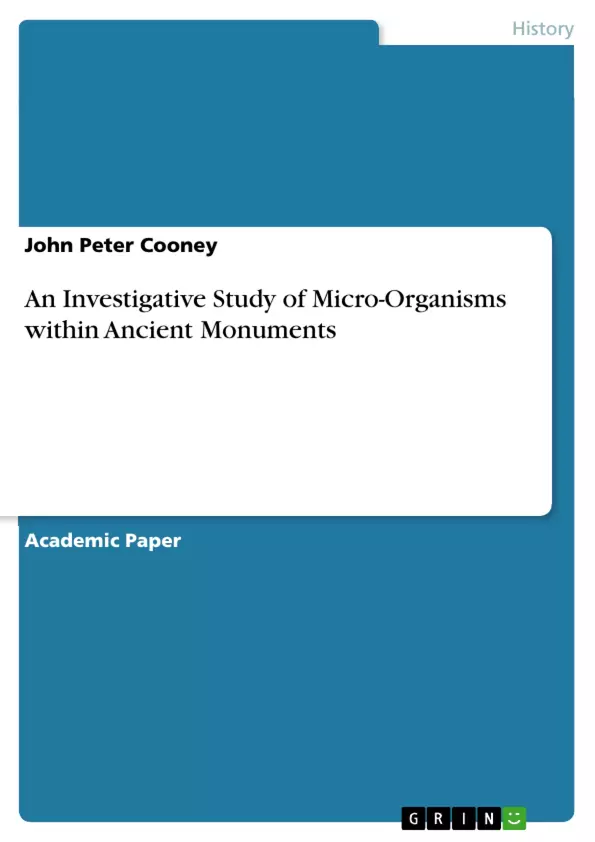Owing to the role that micro-organisms play, it can be seen that the need to comprehend the composition and functionality of complex microbial groups, within ancient structures, is important as to ascertain if it is dangerous to health. This can be shown within a process of demolition and refurbishment on a heritage building information modelling platform.
For the identification of such micro-organisms, two applications are considered for the identification and data collection. Firstly, Metagenomics applies and utilises a set of genomic advances and bioinformatic instruments, which will access and identify the microbial communities content, within structure, as it allows a culture free identification within a natural and/or host associated micro-organism community, and to provide and give insight to the micro-organisms structure, dynamic and function within a prescribed environment.
Secondly, Polyremase Chain Reaction (PCR) allows for the detection and production for large amounts of DNA, found within structure. This particular technique is commonly used to detect and identify illnesses, clone and sequence genomic families and to undertake very sophisticated quantitative genomic work at a very sensitive level. However, the use and application of both procedures have never been considered or sought for the detection of micro-organisms, within an ancient monument setting. This paper will primarily look at the two applications in a specific scientific manner, as to establish and understand its relevance and subsequent ability for data collection and sequencing within the ancient structure.
Inhaltsverzeichnis (Table of Contents)
- Introduction
- Practical Data Collection
- Polyremase Chain Reaction (PCR)
Zielsetzung und Themenschwerpunkte (Objectives and Key Themes)
This paper investigates the presence and composition of microbial communities within ancient monuments, specifically Moreton Corbet Castle, using a combination of Metagenomics and Polyremase Chain Reaction (PCR) techniques. This research aims to establish a standardized method for data collection and analysis of microbial communities in ancient structures, contributing to a deeper understanding of their role in heritage preservation, health and safety considerations during refurbishment, and the historical context of microbial colonization.
- Identification and characterization of microbial communities in ancient monuments
- Development of a standardized data collection and analysis methodology for ancient monument microbial studies
- Assessment of health and safety implications associated with microbial presence in ancient structures
- Exploration of the historical context of microbial colonization within ancient monuments
- Potential for application in heritage preservation and refurbishment practices
Zusammenfassung der Kapitel (Chapter Summaries)
- Introduction: This section introduces the research topic, highlighting the significance of ancient monuments in the UK and the need to understand the composition and function of microbial communities within these structures. The paper outlines the specific methodologies to be employed, namely Metagenomics and PCR, and the chosen case study, Moreton Corbet Castle. It emphasizes the importance of considering health and safety implications associated with microbial presence.
- Practical Data Collection: This chapter details the methodology for data collection at Moreton Corbet Castle, focusing on the specific locations, sample extraction techniques, and storage procedures. It includes illustrations of the site, sampling points, and equipment used. The chapter emphasizes the importance of hygiene during sample collection and the need to capture a representative range of microbial communities.
- Polyremase Chain Reaction (PCR): This chapter focuses on the PCR technique, outlining its application in DNA amplification and the identification of microbial communities. It discusses the principles of PCR, its components, and its significance in genomic fingerprinting. The chapter highlights the potential of PCR for analyzing interdispersed repetitive DNA sequences in various bacterial strains.
Schlüsselwörter (Keywords)
The key terms and concepts explored in this paper include DNA, Genome, HBIM, Micro-organism, Metagenomics, Norman, Polyremase Chain Reaction, Tudor, microbial communities, ancient monuments, heritage preservation, health and safety, historical context, refurbishment.
- Quote paper
- John Peter Cooney (Author), 2019, An Investigative Study of Micro-Organisms within Ancient Monuments, Munich, GRIN Verlag, https://www.grin.com/document/503428



